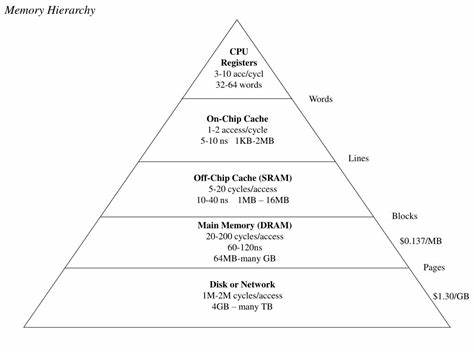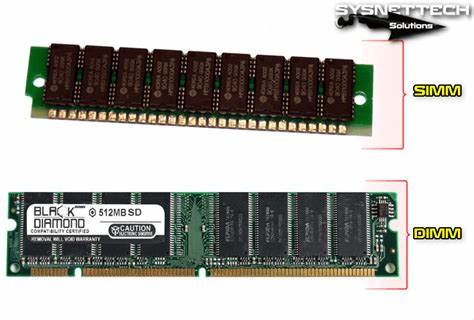32-bit vs 64-bit Systems: A Quick Guide
 Yvonne Aderogba
Yvonne AderogbaIntroduction:
You've probably seen the option to download a software program (application or game) as a 32-bit version or a 64-bit version. The difference does, in fact, matter because the two were created for different systems.
In the computer world, 32-bit and 64-bit refer to the type of central processing unit, operating system, driver, software program, etc., that utilizes that particular architecture.
How did we get here?
Computer Systems can be divided into a simple memory organization hierarchy; the lowest in the hierarchy is the hard drive/ disk, the RAM (Read-only Memory), the Cache memory, the register found in the CPU

Memory Evolution:
Older RAM types, such as SIMMs (Single Inline Memory Modules), were based on a 32-bit architecture. This meant that the CPU could only access 32 bits (4 bytes) of data per clock cycle, with a maximum addressable memory limit of 4 GB (2^32 bytes). In practice, this usually provided only around 3.5 GB of usable RAM due to system reservations. This limitation forced the CPU to frequently access data from the hard drive, which significantly slowed down system performance—a highly undesirable scenario.
To overcome these limitations, DRAM (Dynamic Random Access Memory) was developed using a 64-bit architecture. This allowed the CPU to access 64 bits (8 bytes) of data per clock cycle, greatly expanding the theoretical RAM limit to 16 exabytes (2^64 bytes). Although modern systems don't typically reach this limit, the increased capacity allows for much larger amounts of RAM, enhancing overall system performance and reducing the need for slow hard drive accesses.

Processor Architecture:
The terms 32-bit and 64-bit not only refer to memory architecture but also to the way the processor handles data. A 32-bit processor can process 32 bits of data at a time, while a 64-bit processor can handle 64 bits. The move from 32-bit to 64-bit systems has allowed for faster processing, greater memory addressing, and the ability to run more complex and memory-intensive applications.
This progression in memory and processor architecture has led us to modern 64-bit systems, which offer superior performance, enhanced security features, and the ability to support much larger memory capacities compared to 32-bit systems.
Operating Systems:
The evolution from 32-bit to 64-bit architecture also had a significant impact on operating systems.
32-bit Operating Systems:
Designed to run on 32-bit processors, these operating systems can only address up to 4 GB of RAM.
Even if installed on a system with a 64-bit processor, the OS would still be limited to using just 4 GB of memory.
The software and applications running on a 32-bit OS must be specifically compiled for 32-bit architecture, which limits performance when handling large data or running memory-intensive applications.
As system demands grew, this memory limitation became a bigger issue, especially in environments requiring heavy multitasking or large applications.
So the 64-bit Operating System was introduced:
These OSs can address much more memory, far beyond the 4 GB limit, with many supporting up to several terabytes of RAM depending on the system’s hardware.
A 64-bit OS can run both 64-bit and 32-bit applications, although 64-bit applications are optimized to take full advantage of the system’s capabilities. This made the transition to 64-bit systems smoother for both users and developers.
Differences between the Architectures
| 32-bit | 64-bit | |
| Number of bits | 32 | 64 |
| Architecture and Software Description | 32-bit architecture is based on the data buses being 32 bits (4 octets) wide. For software, 32-bit typically means use of 32-bit linear address space. | 64-bit architecture is based the data buses being 64 bits (8 octets) wide. For software, 64-bit means code use with 64-bit virtual memory addresses. |
| Compatibility | 32-bit operating systems (OS) and applications require a 32-bit processor. | 64-bit OS requires a 64-bit processor, and 64-bit applications need a 64-bit OS and processor but 32-bit applications can run with a 64-bit OS and processor. |
| Memory Limits | 32-bit systems are limited to 4 GB of RAM. | 64-bit systems can theoretically allow up to 16 exabytes (16 billion GB) of RAM. |
| Price | 32-bit operating systems are cheaper to install | 64-bit operating systems are more expensive to install |
| Installation Files | 32-bit applications only have one installation file. | 64-bit applications have two installation files, one in the 64-bit format and the other in the 32-bit format |
| Multitasking | Can handle multiple tasks but with limited efficiency | Can handle multiple tasks more efficiently |
| Gaming | Can run high graphical games, but may not be as efficient as with 64-bit OS | Can run high graphical games and handle complex software more efficiently |
| Virtualization | Limited support for virtualization | Better support for virtualization |
To check your system's OS
If you are running Windows on a computer less than 10 years old, your chip is almost guaranteed to be 64-bit, but you may have installed a 32-bit version of the OS. It's easy enough to check.
In Windows 10, go to Settings > System > About or type About in the Windows 10 search box. Under the Device specifications heading, you'll see it at System type, read this: What's the Difference Between 32-Bit and 64-Bit? (lifewire.com) to figure out if there is cause for concern.
In Summary
Processors: 64-bit CPUs are more powerful, can handle more data at once, and address more memory.
Memory: 64-bit systems can address more RAM, leading to better performance in high-demand applications.
Operating Systems: 64-bit OSs are more versatile, supporting both 32-bit and 64-bit applications, and can handle more memory and processing power.
Overall, 64-bit systems are the best for modern computing due to their superior performance, capacity, and flexibility.
Subscribe to my newsletter
Read articles from Yvonne Aderogba directly inside your inbox. Subscribe to the newsletter, and don't miss out.
Written by
